Top Tens
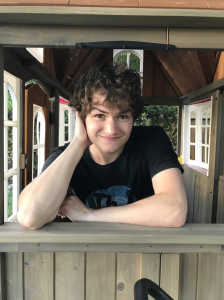 Dylan O’Connor
Dylan O’Connor
Dylan O’Connor graduated with a double major in Mathematics and the Film and Media Studies concentration in English and Comparative Literature and a minor in French in 2020. In the fall he will attend the Graduate Center at the City University of New York to pursue a PhD in Mathematics.
Strangers on a Train (Alfred Hitchcock, 1951)
The way that Hitchcock stages this encounter between tortured tennis star Guy (Farley Granger) and charismatic murder-enthusiast Bruno (Robert Walker) lets the latter drip seduction, even when the former punches him in the face and especially when Bruno stalks Guy’s wife through a carnival. Hitchcock’s transfer of guilt might seem unfair to upstanding Guy, but the film’s “happy” ending proves that not only is Bruno right about Guy’s dark desire, but that the Hollywood-weaned audience of the 50’s wanted the same thing.
Cléo de 5 à 7 (Agnès Varda, 1962)
In the opening minutes of this film, a shot of the titular heroine (Corrine Marchand) going down the stairs repeats three times, seemingly breaking the “real time” rule set out by the film title before the game has even begun. But Varda plays a different and far more interesting game–using montage to render time in ways that respond to Cléo’s emotional state and revealing in the process that clock time is no more real than cinematic time.
Police Story (Jackie Chan, 1985)
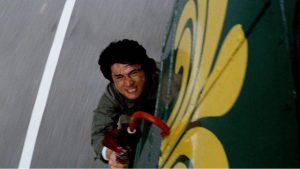
The action movie must be one of cinema’s purest expressions when done right–Jackie Chan makes sure you see every punch, kick, and death-defying pole-slide from at least two angles. The little “pop” of a film cut becomes punctuation for stunts worthy of Buster Keaton or Charlie Chaplin.
Tim’s Vermeer (Teller, 2013)
Tim merely projects a Vermeer painting out into a room as it would look if it were a view of the room through a lens, then projects the room back through the lens to paint it. Flawed as his experiment is, this documentary about Tim Jenison and his theories about Vermeer still reveals cinema’s secret origin in painting. Even if Vermeer didn’t use a lens while he painted, he was thinking like a man with a movie camera, placing his subjects just so, imagining what they would look like in the perspective of a lens, framing them in a rectangle and then “painting with light,” as art critics have called it.
Bigger Than Life (Nicholas Ray, 1956)
The Hollywood executives who okayed the final cut would have you believe that normalcy and goodness have returned when James Mason smiles and hugs his family in the hospital bed at the end of this film, but Ray makes it feel hollow. Mason’s manic performance in the scene is just a new kind of derangement for the character, and Ray forces you to confront the fact that the cruelty Ed Avery inflicts on others is not purely a result of his reliance on cortisone- his evils merely take common American desires like expensive clothing and a football-star son to ugly extremes.
Two Days, One Night (Jean-Pierre Dardenne and Luc Dardenne, 2014)
This fiction film makes an excellent case for documentary film-making as therapy. A face-to-face encounter with someone can help you become a better person. It can even give you a reason to live, as it does Marion Cotillard’s character.
Cameraperson (Kirsten Johnson, 2016)
This movie could punctuate an entire alternate history of cinema, where narrative and continuity never overran the cinema of attractions and associational or contrasting forms of montage. Instead of using cinema to tell a story, Johnson uses cinema as something more like a thinking machine, pulling her audience through her memories of shooting other people’s movies in a way that feels almost like telepathy.
Meshes of the Afternoon (Maya Deren, 1943)
This film, too, reveals cinema’s potential to do more than tell a straight story, employing editing tricks that would have made Méliès jump out of his seat to tell a nightmarish, circular, magical, and puzzling tale of domestic strife.
Under the Skin (Jonathan Glazer, 2013)

The surrealists would sometimes wander into a movie theater in the middle of a showing so that they could enjoy the images and sounds without the distractions of context and narrative. By excising most of the exposition and almost all of the words from his source novel, Glazer gives us the very surreal pleasure of wondering at characters’ strange behaviors and never quite figuring everything out.
The Gleaners & I (Agnès Varda, 2000)
Taking the sum of a few of the above lessons, we might say that the key to film-watching is to open yourself to others’ ideas, no matter how obscure, unusual, mean-spirited, or even flat-out wrong they might be, and then to interpret thoughtfully. Varda goes further in this documentary, “gleaning” others’ lives and ideas with her camera and making them part and parcel of her own self-portrait, even in the very title. We would all do well to be so radically empathetic in our lives and in our work.

Julia Stamey
Julia Stamey (class of 2021) is a Double Major in Communication (focus in Media Production) and English/Comparative Literature (focus in Film Studies). She is also a minor in Anthropology, although when asked she normally just refers to herself as a “film major,” as she is a firm believer that her film education at Carolina would not have been complete without the dual background in production and theory. She loved serving as the President of the Carolina Film Association during her time as a full time student at UNC, and can still be spotted on multiple CFA sets. Now, having finished all of her graduation credits, she is taking the spring semester off to work on multiple film projects including Fix, a feature-length musical (check out bspro2020.weebly.com for more info) and save up money for her summer move to LA with the Hollywood Internship Program offered through the Communication Department!
La Jetée (Chris Marker, 1962)
If I had to pick a number one favorite film, it would be La Jetée. This is the film I make everyone watch, and yes, every film deserves the justice of being watched in the dark with a good sound system, but with this one I have to insist. What is so clever about this film is the way it exemplifies the number one rule of filmmaking: good audio, and you can do anything you want with your image (conversely, bad audio, and not even the most magical image can save your movie). The narration lures you into a state of hypnosis, the still photos play with temporality in a way that is masterful, and the only shot that is actually a moving image in the whole film is so subtle you might blink and miss it, and yet communicates more than many entire films manage to do, all in under 30 minutes. I could go on and on (and I apologize to all of my friends who have let me).
Get Out (Jordan Peele, 2017)
What can I say, I’m a sucker for heavy-handed symbolism! Heavy-handed doesn’t always mean bad, of course—in fact, I think that’s what makes this film so fun. Every moment is so intentional, so well crafted, you cannot possibly derive all of its meaning from one viewing; and yet, at the same time, some of the symbolism is so surface level, it is impossible to miss. To me, this surface level symbolism is intentional—it draws you in, makes you want to look for more. I think I saw it five times in theaters, and still manage to find a new interpretation with new viewings.
Parasite (Bong Joon-ho, 2019)
I can’t imagine anyone taking the time to read my Top 10 hasn’t seen this film, so I don’t feel like I need to say much about it (if not, why are you wasting your time with me? Go watch it!). One thing I will point out is how, in some ways, it is similar to Get Out (a social commentary thriller, heavy handed on symbolism, with moments of laughter). Not to suggest that Parasite isn’t deserving of its awards, or that it isn’t in many ways a stronger film than Get Out, but interesting that a foreign film of this nature was considered high art in America, winning Best Picture, when a “black” film of the same nature was categorized as a comedy at the Golden Globes.
1917 (Sam Mendes, 2019)
Yes, 1917 is another World War movie, and yes, the one-shot thing was a gimmick. But George MacKay’s performance was outstanding, and the one-shot trick had a disorienting, isolating effect that I can only presume imitated the reality of the desperation of the battlefield.
The Grand Budapest Hotel (Wes Anderson, 2014)

It was a tough choice between this film and Fantastic Mr. Fox (I adore stop-motion, and aspire to find the right script for a live-action stop-motion one day), but The Grand Budapest Hotel gets well-deserved points for Wes Anderson at the top of his aesthetic craft. It isn’t stop motion, and yet feels almost as mechanical, the design is so meticulous. Ralph Fiennes is also incredible, of course.
Last Holiday (Wayne Wang, 2006)
Yes, you’ve probably seen this on ABC Family or the Lifetime Movie Channel. It still makes this list for two reasons, the first being fat girl representation. It might be hard to remember in 2021, but the Third Wave Body Positivity Movement began around 2012, and even today, fat people onscreen are usually the butt of jokes, or characterized by their unattractiveness. Queen Latifah’s Georgia in Last Holiday, on the other hand, is nothing but beautiful—not in spite of her fatness, just beautiful. The only thing her character must overcome is insecurity; she is seen enjoying food and we root for her to do it! Secondly, Queen Latifah’s onscreen presence holds a certain charisma that is essential to the film. I would not go so far to claim that she gives an Oscar-winning performance in Last Holiday, but there is a certain intrinsic charm she brings in front of the camera that is almost magical; like she is always both the warmest and the smartest person in the room. As Roger Ebert writes, “It is good to attend to important cinema like ‘Syriana’ and ‘Munich,’ but on occasion we must be open to movies that have more modest ambitions: They only want to amuse us, warm us, and make us feel good. ‘Last Holiday’ plays like a hug” (Ebert).
Harvey (Henry Koster, 1950)
Harvey was the first stage play I ever directed, so if I’m being honest with myself it’s difficult to separate the nostalgia from the film alone. But there is something so charming about that script, onstage and onscreen, it deserves to be awarded in any medium. And to be fair, no high school actor could deliver the quintessential line better than the great Jimmy Stewart: “Years ago my mother used to say to me, she’d say, ‘In this world, Elwood, you must be’ – she always called me Elwood – ‘In this world, Elwood, you must be oh so smart or oh so pleasant.’ Well, for years I was smart. I recommend pleasant. You may quote me.” Indeed, I find myself quoting him often.
The Last Black Man in San Francisco (Joe Talbot, 2019)

Watch this movie because it is the most aesthetically beautiful film I have ever seen, and then let the plot twist your heart into a knot as it tackles an unsolvable injustice that is both no one’s and everyone’s fault. About gentrification, truth, and so much more.
Three Billboards Outside Ebbing, Missouri (Martin McDonagh, 2017)
I have had such strong emotions ripped out of me as during this film. Luckily I attended a late showing so I don’t think there were many other people in the theater (at least I hope there weren’t), because when I tell you I cried out loud, I mean out loud. Frances McDormand deserves her Oscar for this film, and all the other performances deserve their applause as well, particularly Sam Rockwell and Woody Harrelson.
Eve’s Bayou (Kasi Lemmons, 1997)
Eve’s Bayou is a beautiful film about memory and trauma. Throughout the film, we are never quite sure what is true and what is warped by memory—a theme that is accomplished so beautifully within the medium I become less certain of “the truth” with each viewing, appreciating it more every time.
 Veronica Chandler
Veronica Chandler
Veronica, class of 2021, is a founding editor of Aspect. She is majoring in English and Comparative Literature with a concentration in Film Studies, and minoring in Anthropology. She is interested in all forms of film and television in any genre, whether it be live action, stop motion, or animation. As an editor for Aspect, Veronica is most interested in collaborating with other writers passionate about film and television. Veronica has been published in The Pit Journal, and is currently working on an honors thesis that explores the ways in which Hollywood’s age-old practices impact minority creators. She is committed to helping writers enhance and refine their pieces, and highlight their talent. Veronica aspires to become a writer and producer after graduating from UNC. Her hobbies outside of the classroom include running, reading, and drawing. Her favorite author is Donna Tartt, and my favorite film genre is thriller/suspense. Her greatest inspiration in filmmaking is director, actor, producer, and acting studio head Tasha Smith.
Devil in a Blue Dress (Carl Franklin, 1995)
Devil in a Blue Dress is an underrated classic that delves into the neo noir genre. Denzel Washington gives a captivating performance as Ezekiel “Easy” Rawlins, a man who gets unwittingly wrapped into a scandal that involves several characters who each have their own agenda. It is rare to see a noir film where black characters are the protagonists, and I enjoyed seeing a film where blackness was treated as the norm rather than the exception. I also guarantee viewers will love Don Cheadle as Mouse, truly no actor out there could play him.
Fargo (Joel Coen, 1996)
Fargo is my most recent watch on this list, and I regret not seeing it sooner. It takes place in Fargo, North Dakota, where a police officer (Frances McDormand) realizes that a car accident is more than an unfortunate crash on the ice. I think the best thing about this movie is its simplicity. It takes its time in fleshing out the characters, so the stakes of the film actually feel real.
The Fugitive (Andrew Davis, 1993)
There is nothing better than a film where two characters go head to head in a battle of wits. In The Fugitive, Harrison Ford plays a heart surgeon who is accused of murdering his wife. As the title suggests, he evades capture and becomes the target of a police team headed by Deputy Gerard (Tommy Lee Jones). My favorite aspect of this film is its meticulous attention to its characters motivations and actions. It is not a film that cuts corners in order to get to its final act, and it is all the better for it.
The Silence of the Lambs (Jonathan Demme, 1991)
The Silence of the Lambs is chilling in all the best ways. We follow FBI student, Clarice Starling (Jodie Foster), who is forced to interact with Hannibal Lecter (Anthony Hopkins), a psychotic cannibal, in order to find clues to catch another killer on the run. Anthony Hopkins performance is unforgettable, and its particularly striking how he manages to portray such a terrifying antagonist with so little fanfare. He transforms an already strong film to the next level.
Whisper of the Heart (Yoshifumi Kondō, 1995)
Whisper of the Heart is an inspirational film that speaks to a universal struggle to find one’s place in the world. We’re first introduced to Shizuku Tsukishima (Yōko Honna), a bookish middle school girl, who finds herself adrift in the midst of high school exams. She is inspired by an aspiring violinist, Seiji Amasawa (Issei Takahashi) who she serendipitously meets throughout town. Shizuku’s emotions are so real and with a dose of relatable awkwardness, that the film becomes a quintessential coming of age story – without the overdone melancholia that so many other coming of age stories have.
The Iron Giant (Brad Bird, 1999)
I don’t know where to begin with The Iron Giant, there’s just too many great things to say. The story begins with a huge unidentified object landing in the ocean. The next day we are introduced to Hogarth (Eli Marienthal), a precocious boy who is starved for company in a town that doesn’t really appreciate creativity. When he finds the Iron Giant (Vin Diesel – who knew?), the two bond over their mutual loneliness. The director and the creative team behind this film really knew how to build the tension in a scene. From the beginning, the visuals and the sound pull you into the events, and the pacing is nearly perfect.
Widows (Steve McQueen, 2018)

Widows incorporated some of my favorite scenes and moments in film. Steve McQueen and Gillian Flynn launch the viewer into a world of four women who are desperate for security after the people they trust the most let them down. Viola Davis plays Veronica Rawlings, a widow grieving the recent loss of her husband. She is joined by three other women, portrayed by Michelle Rodriguez, Cynthia Erivo, and Elizabeth Debicki, all of whom are three dimensional and well developed which is difficult to achieve in a heist film. One of the best things about this film was the way its character’s battled for power in every scene.
Moonlight (Barry Jenkins, 2016)
I think what makes a great film is if you still think about it days, months, weeks after you’ve seen it. For me, Moonlight is a film that I constantly find myself returning back to. Barry Jenkins tells the story of Chiron, (Alex Hibbert, Ashton Sanders, Trevante Rhodes) a young black man growing up in Liberty City, Miami. Barry Jenkins tells Chiron’s story in three stages: youth, adolescence, and adulthood. Every actor who portrays Chiron at each stage is phenomenal, and although the events of the story are simple, the emotions that are carried in each scene carry so much weight. Chiron is a person who people don’t instinctively root for, and Barry Jenkins like all talented creatives, challenges viewers to empathize with – rather than judge – his characters.
Don’t Look Now (Nicolas Roeg, 1973)

Don’t Look Now is a film with shocking surprises and plot twists. The film begins with a tragedy. A couple John and Laura Baxter (Donald Sutherland, Julie Christie) lose their daughter in a drowning accident. In the midst of their grief, John is called to Venice to restructure a church and his wife accompanies him. From there, the film becomes more and more eerie and unpredictable. The film’s editing style is very unique, and although the plot suggests a story about mourning and healing, the ending is impossible to predict.
In Bruges (Martin McDonagh, 2008)
In Bruges is a film that is impossible to categorize. It is a film noir, a tragedy, a horror, a thriller, and also, one could argue, a love story. The film is about a pair of assassins, Ken (Brendan Gleeson) and Ray (Colin Farrell) who are exiled to Bruges after Ray fumbles a mission. Although the plot hints at action and drama, the majority of the running time is dedicated to showcasing works of art around Bruges. Watching the characters go to a museum or church may not seem entertaining, but its actually Ray and Ken’s reaction to the pieces that brings the film to life. I was so invested in the characters, that to this day I have only seen it once. It’s also an homage to Don’t Look Now. I suggest a double feature of the two.
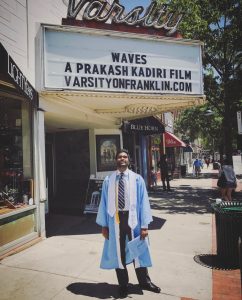 Prakash Kadiri
Prakash Kadiri
Prakash graduated in 2017 as an English and Comparative Literature major, with a minor in Writing for the Screen and Stage. He is currently a Third Year Law Student at UNC. As an undergraduate, he founded the Carolina Film Association so that students could work on films in an extracurricular capacity. He also wrote, directed, and produced a 50-minute narrative film, Waves, shot entirely on 16mm film stock as his undergraduate Honors Thesis. The film premiered at the Varsity Theatre on Franklin Street and the Gem Theatre in Kannapolis, NC. The film’s poster hangs up on the second floor of the Graham Memorial on campus alongside a description of the production process. He is currently attending law school at UNC. He writes: “In a world inundated with images, the power to understand and analyze what all forms of media intend is not only helpful, but essential. The exercise of watching movies and engaging actively with them developed my critical thinking skills and nurtured a creative perspective that encouraged free-form associations. Although I initially pursued a career in filmmaking, I chose instead to pursue a legal career, where my background and skill set have proven to be not only unique but crucial. The understanding of narrative and presentation is relevant in any industry. In the legal field, the difference between a lawyer who merely makes his case and a lawyer who can craft a story for the jury is remarkable. In my experience, the jury has always sided with the latter.”
North by Northwest (Alfred Hitchcock, 1959)
I remember seeing this film for the first time in my first semester at UNC. In film classes, you often have to re-watch a film 2-4 times, but this film I enjoyed watching over and over and over. It’s just simply so fun and gripping. It set the template for James Bond films that would come in the next decade. I remember Hitchcock jokingly advertised this film as a big tourist adventure alongside Cary Grant and Eva Marie Saint – and it partly is. It’s that diversity in settings and not knowing where the story will lead next that I love about this film and the Bond films that follow. I also met Ms. Eva Marie Saint in 2017 and have a wonderful photograph with her. (That is attached.)
Singin’ in the Rain (Gene Kelly and Stanley Donen, 1952)
This film is pure magic. I could watch this on replay forever. It’s a perfect blend of comedy, drama, and music. Historically, it’s a great story about the advent and challenges of introducing sound in movies – which I think make for some of the funniest and most rewarding scenes. It never fails to bring a smile to my face.
Lawrence of Arabia (David Lean, 1962)

In 2015, I rented out a local theatre because I wanted to watch this film on the big screen and share that experience with other film lovers in the UNC community. The story of T.E. Lawrence as told by David Lean is marvelous. It’s a lengthy film gorgeously shot on 70mm – I have a single film cell framed. I don’t think any studio would make a film like this ever again. Lawrence’s journey across the Middle East as he tries to unite different tribes is extraordinary. For me, this film really about the process and journey and not the outcome.
Interstellar (Christopher Nolan, 2014)
I know many rank this near the bottom of Nolan’s filmography, but I think it imparts two very important things about humanity. First, as humans it is in our DNA to be adventurers and delve into the unknown – not doing so is to deny our own programming. Secondly, Love is one of the greatest powers in the universe. I strongly believe people who misunderstand love miss the gravity of the second message.
Blade Runner series (Ridley Scott, 1982 and Denis Villeneuve, 2018)
Blade Runner is a world that operates on its own terms. The first film is slow to start, but is thrilling once it picks up and eaves the audience with so many questions. It also has the most iconic soliloquy’s in cinematic history. I was hesitant to see 2049 initially because I felt it would not live up to the first. I eventually saw it near the end of its theatre run and immediately regretted not seeing it earlier so that I could watch it at least 3 times in theaters. These films really delve into the question of “What makes us human?” With AI on the horizon, that will be an issue we will deal with ourselves in the distant future.
Akira (Katsushiro Otomo, 1988)
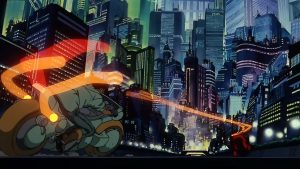
What happens when humanity goes beyond its limit? That is what Akira means to me. This almost serves as a companion piece to the original Blade Runner as both take place in 2019 in a cyberpunk world deprived of comforts of contemporary life. The film and manga go in different directions with their endings are both worthwhile uses of one’s time. It is also eerie how this film predicted Tokyo hosting the Olympics in 2021.
The Kid (Charlie Chaplin, 1921)
When I first moved to the US in 2000, I knew no English. That language barrier put most shows and movies beyond me. But my parents knew Chaplin and we would check out VHS tapes of his films from the local library. It’s honestly a shame that Chaplin has a larger place in the public conscious abroad than in America. I love all the films featuring Chaplin’s Tramp but the ending of The Kid as the lovable Tramp runs to reunite with the kid struck an emotional chord with me as a five-year-old.
Finding Nemo (Andrew Stanton, 2003)
I still remember clearly seeing Finding Nemo with my father as a kid. I think I’m just a sucker for any story about the love between a father and child. Finding Nemo gave us such memorable characters in Nemo, Marvin, and of course Dory. It’s fun, touching, and a remarkable journey across the ocean to reunite father and son. I think it’s Pixar’s finest.
Mission: Impossible series (1996 – ongoing)
I love the Mission: Impossible movies and think that Tom Cruise and Jackie Chan are the finest action stars that have ever existed. They’re not really about plot as much as about Tom Cruise pulling off jaw dropping stunts. My favorite remains Ghost Protocol (M:I 4) as that was the first I ever saw in theaters, but they just keep getting better. I love how McQuarrie and Cruise go about making these films. The story builds around where they want to shoot and what stunts they want to do. That sounds like a rewarding adventure in filmmaking to me.
Fast and Furious series (2001 – ongoing)
The first one I saw in theaters is still my favorite, Fast Five, but I love all of these films. I remember in 2011 when Fast Five came out, it was only minorities in that theatre. I don’t think these films get enough credit for giving us a band of minority heroes in the forefront of all the action, not to mention the music is a blast. These films are more than just spectacle – they’re about family.
 Yuma Kobayashi
Yuma Kobayashi
I am a double major in Film Studies and Psychology B.S. who cooks as much as he watches film. I am a practicing screenwriter in search of a film production job in the wake of the coronavirus; however, job or no job, films abound in this era of streaming, so no matter how bleak times look, that’s comfort enough to stay content. I am very grateful for having had the opportunity to volunteer at Sundance, coordinate the student symposium at Film Fest 919, work alongside students in filmmaking projects, and contribute everything I could to growing the Film Studies program. All I have in leaving is excitement for the future of film and its study.
Slacker (Richard Linklater, 1990)
Slacker is a filmic collage intertwining a multitude of characters whose paths superficially intertwine to represent the social landscape of Austin, Texas. The film abandons a central narrative in favor of weaving a social tapestry of brief, provocative dialogue snippets and was one of my first introductions to non-linear narrative filmmaking.
Network (Sidney Lumet, 1976)

One of my personal all-time favorites, Network represents so much of what was so good about the New Hollywood age of American cinema. Its relevancy and story act as expert commentary on our relationship to entertainment and reality. The brilliance of the film is in its writing; if you watch it as a comedy, it’s hilarious, but it still can hold up as a serious drama in spite of such satire.
Mr. Nobody (Jaco Van Dormael, 2009)
One of my personal favorite science fiction films, Mr. Nobody goes further than much narrative-based science fiction will in the realm of the impossible. Exploring the potential and possibility of life from the perspective of the last man to die of old age, the film contrasts the endless potential of an age-bound life to the limitations of an ageless and rational technological world and tells it beautifully through the age-old stories of love and loss.
Stalker (Andrei Tarkovsky, 1979)
Stalker was my introduction to contemplative cinema and to Tarkovsky’s style of Russian science fiction. The brilliance of the film, for me, comes in its use of the audience’s imagination as its central conflict. Though its source material conveyed more visual ideas for the possibilities of the Zone, Tarkovsky’s take on the world relies on the philosophical arguments between its central characters, with the “science fiction” played out invisibly and not as an action film set piece.
Man with a Movie Camera (Dziga Vertov, 1929)
Another Russian film influence, Man with a Movie Camera utilizes the full breadth available to the filmmaker and demonstrates the power of editing film. Artistic and provocative in its association between humanity and its creations, the film embraces the meta potential of film and remains the epitome of cinematic reflexivity.
Eyes Wide Shut (Stanley Kubrick, 1999)
Eyes Wide Shut, despite being Kubrick’s final project, still receives less acclaim than his other work. But I believe the beautiful use of color and the stylized acting alone make this film worth watching. Pairing those tools with the backdrop of a sexually-malfunctioned middle class marriage and the surreal side of urban society make for a truly extravagant viewing experience.
Akira (Katsuhiro Otomo, 1988)
Akira is a precious example of animation in its full capacity. Imbued with intense violence and destruction, the film grapples with Japanese history in a dystopic setting, thus fusing the past and future in a horrific amalgam of flesh and metal. With a film score that doubles these themes and an animation that meticulously replicates the sensation of a real camera, Akira is a must-see for anyone interested in cinema.
Rear Window (Alfred Hitchcock, 1954)
Few creators reach that level of praise of Hitchcock’s, and for good reason. Rear Window is an expert example of American storytelling, exploring the ethics of that voyeurism which we, the audience, share with the film’s main characters.
Eternal Sunshine of the Spotless Mind (Michel Gondry, 2004)
A deconstruction of the relationship between film and memory, this film folds into its narrative a question that tears at the worries of everyone: what are we but the memories we retain? Are we better for forgetting ourselves or are we doomed to never appreciating every bad memory we retain? Does technology’s role in easing our lives also forsake confronting our relationships? As scripted by Charlie Kaufman, the film’s non-linear approach coincides with these themes, blending what was, is, and will be into an unfolding scrutiny of the human condition.
Sans Soleil (Chris Marker, 1983)


One of the great possible avenues of cinema comes in the form of the essay film, one of contemplation and exploration. Marker’s film, Sans Soleil, uses essayistic approaches to question the role of images and culture, while weaving through an array of topics, international locations, and histories.
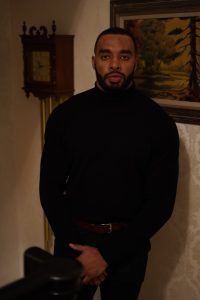 Jake Lawler
Jake Lawler
Jake, class of 2020, earned numerous academic accolades as a college athlete and created various media programs, from multimedia nonprofit UNCUT to film and culture podcast Inside the Film Room, during his time at UNC. Jake leaves Chapel Hill with a degree in broadcast journalism. The former Tar Heel linebacker moved to Los Angeles to pursue a career as a screenwriter in the entertainment industry. He has written a few short films, one of which finished shooting in Charlotte in July 2020, and a few television pilots. He hopes to tell a wide range of stories for a wide range of people.
Skyfall (Sam Mendes, 2012)
Daniel Craig’s Bond is at his very best here, as well as literally everyone else in the film. Incredible action sequences, brilliant pacing, and one of the best Bond villains ever in Javier Bardem’s Raoul Silva, it’s a film I try to watch more than once every year.
Grand Budapest Hotel (Wes Anderson, 2014)
If his films are any measure of his character, Anderson must be one of the loveliest people to walk the Earth. An exquisite and marvelous narrative that’s as deeply thoughtful as it is hilarious.
Mad Max: Fury Road (George Miller, 2015)
One of the two films that made me decide that I wanted to work in the entertainment business. A glorious, masterful victory lap from George Miller, Fury Road is easily one of the greatest cinematic achievements in history.
Steve Jobs (Danny Boyle, 2015)
If the Gods could speak, they would speak in Sorkin. One of the greatest films that you’ve never seen, Jobs’ glorious script is elevated by some of the most remarkable performances in recent memory.
Arrival (Denis Villeneuve, 2016)

Villeneuve is one of the greatest working directors and with films like this, it’s not hard to see why. A beautiful, mesmerizing journey rife with palpable social commentary, it’s out-of-this-world (so sorry but it was right there).
Logan (James Mangold, 2017)
It may just be my attachment to Hugh Jackman’s Wolverine, but this is the closest I’ve ever come to crying in a theater. Mangold’s measured and sobering direction coupled with some truly visceral performances from Jackman and Stewart brings Logan to life, and to death.
War for the Planet of the Apes (Matt Reeves, 2017)
How Reeves was able to craft one of the most emotionally resonant blockbusters in history using CGI apes is something that I have never been able to get over. This film, and Andy Serkis’ performance, is just beautiful through and through.
Spider-Man: Into the Spider-verse (Bob Persichetti, Peter Ramsey & Rodney Rothman, 2018)
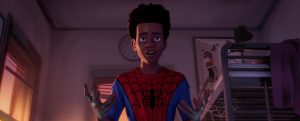
Representation matters and Spider-verse does one of the finest jobs in film history of showing Black children as more than just slaves and criminals. It’s gorgeous to look at and fully engaging from start to finish.
Once Upon a Time…In Hollywood (Quentin Tarantino, 2019)
Rick Dalton in the trailer will forever be one of the funniest scenes I’ve ever had the pleasure of watching. It’s smart, sleek, stylish, and another addition to the incredible Tarantino collection.
Parasite (Bong Joon-ho 2019)
A remarkably affecting social satire/thriller, everything from the ensemble to the production design works to deliver one of the sharpest and most exceptional stories of my moviegoing experience. Mr. Bong, you have my RESPECT!!!
 Lexi Baird
Lexi Baird
Lexi, class of 2021, is double-majoring in Neuroscience and the Film Studies Concentration in English and Comparative Literature. She plans to complete a PhD in Cognitive Neuroscience after graduation. Lexi also has worked part-time as a sports photographer since she was twelve. After taking a film theory class as a sophomore, she realized she wanted to take as many film classes as possible.
The Cabinet of Dr. Caligari (Robert Wiene, 1920)
100 years later, this is still one of the most disorienting and unsettling films to date. As a first-semester freshman at Carolina, I was awestruck with the set design.
Vivre Sa Vie (Jean-Luc Godard, 1962)
As my first exposure to the French New Wave, this film broke all the “rules of cinema” I recognized at the time. Unforgettable.
Mirror (Andrei Tarkovsky, 1975)
Tarkovsky beautifully showcases cinema’s ability to mutate time and memory. Mirror taught me much about how films construct and operate by their own internal logic.
Eraserhead (David Lynch, 1977)
Trying to summarize this film in a sentence is an exercise in futility that I will not attempt. It is perhaps the most mesmerizing display of Lynch’s limitless craft and one of my personal favorites on this list.
Asparagus (Suzan Pitt, 1979)

Appropriately paired with Eraserhead at midnight-movie showings, this dizzying surrealist animation creates a stunning dream world rich with color, sensuality and emotion in a mere 18 minutes.
Dogtooth (Yorgos Lanthimos, 2009)
A pitch-black comedy with more horror than humor. Lanthimos is known to raise more questions than he answers, and this is no exception.
Her (Spike Jonze, 2014)
Her has been close to my heart since my first viewing as a teenager. Discussing Jonze’s take on love within the context of philosophy in Pavel Nitchovski’s ‘Philosophy and Film’ course gave me a fresh perspective on a film I thought I knew inside-and-out.
Cemetery of Splendor (Apichatpong Weerasethakul, 2015)
Patience is a virtue. This film’s intricate atmosphere prompts us to experience it rather than just view it. Cemetery is so entrancing that upon viewing, I couldn’t move and I had to remind myself to blink.
Cameraperson (Kirsten Johnson, 2016)
I came to Carolina with no intention of completing a film degree. That is, until I saw Cameraperson at The Varsity for a class screening. An incredibly thoughtful collage exploring the relationship between the filmer and the filmed, one that made me realize just how powerful cinema can be.
You Were Never Really Here (Lynne Ramsay, 2017)

A brutal deconstruction of the action genre with an atmosphere that extends beyond the screen to infect us with its anxiety-inducing energy—like every action movie should.
 Hayley Sigmon
Hayley Sigmon
Hayley, class of 2019, was a major in English and Comparative Literature, Film Studies Concentration. Her short film, Phoenix, swept the major awards at last year’s CFA showcase (check it out here). Hayley says: “Studying film at UNC gave me the critical knowledge of film theory that has influenced the way I make my own films. I am currently working towards my MFA in Writing for the Screen and Stage at Northwestern University. I am also at work on writing, directing, and producing my own short films independently. I hope to move to Los Angeles and pursue a career as a writer/director.”
Taxi Driver (Martin Scorsese, 1976)
Without a doubt the most influential film in my life. Both psychologically and physically violent, Travis Bickle is an antihero for the ages, and no one gets into his head like De Niro and Scorsese.
Cléo de 5 à 7 (Agnès Varda, 1962)

I credit the class I took on the French New Wave as my filmmaking awakening, when I really became aware of film as a critical and theoretical form as well as an artistic one. Varda’s film was the only one directed by a woman in the course, and I was immediately inspired by her presence in the New Wave where she was surrounded by men.
Lady Bird (Greta Gerwig, 2017)
The relationship between Lady Bird and her mother is one many girls can relate to in this coming of age story. Equal parts heartwarming and heartbreaking.
The Virgin Suicides (Sofia Coppola, 1999)
This film’s dreamlike atmosphere and mood belies its dark core. The examination of girlhood as an unknowable spectacle from a male perspectives invited me to explore more abstract storytelling.
Goodfellas (Martin Scorsese, 1990)
I couldn’t call myself a Scorsese fan without mentioning this film. I love a good gangster film and this is the quintessential one for me.
Moonlight (Barry Jenkins, 2016)
This Best Picture winner is a must-watch. The colors, the triptych structure, the vast wealth of emotion and personal experience—an excellent film.
Thelma and Louise (Ridley Scott, 1991)
A feminist road movie with a tight script and killer leads. Watching Thelma and Louise break free of the trappings of traditional femininity is both extremely fun and engaging on a critical level.
American Honey (Andrea Arnold, 2016)

Clocking in at almost three hours, this film is an endeavor— but well worth it for its epic road drama and beautiful cinematography, as well as its female protagonist, who’s impossible to look away from.
La Haine (Mathieu Kassovitz, 2015)
Scathing social commentary accompanied by homages to film history and stellar lead performances. A gripping watch.
My Own Private Idaho (Gus Van Sant, 1991)
A gut-wrenching examination of unrequited love with some of the most poignant moments of River Phoenix’s career. The chemistry between him and Keanu Reeves is off the charts.
 Miguel Penabella
Miguel Penabella
Miguel graduated with a double major in English and Comparative Literature, and Communication Studies at UNC-Chapel Hill in 2015 before embarking on his current MA/PhD program in Film and Media Studies at the University of California, Santa Barbara. His research deploys the specter as a theoretical framework for examining historical revisionism and questions of national cinema in the Philippines.
Yi Yi (EDWARD YANG, 2000)
My favorite films always change, but this one has always remained at the top. Yang gives an intimate picture of urban loneliness and temporary friendships, of the quiet moments and everyday struggles that shape who we are.
Y Tu Mamá Tambíen (ALFONSO CUARÓN, 2001)
A road trip movie that peels away deeper emotional layers with every passing scene. Practically devastating in the way Cuarón’s camera drifts and lingers on images of a rapidly changing Mexico as its characters come of age.
Happy Together (Wong Kar-wai, 1997)
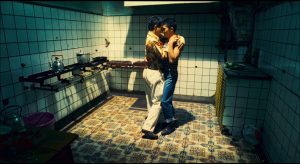
Heartbreaking and turbulent, Wong Kar-wai’s devastating story of an unraveling, toxic romance pairs emotional violence with valuable moments of vulnerability, tenderness, and sublime cinematography.
Where is the Friend’s House? (Abbas Kiarostami, 1987)
A simple yet powerful story of the goodness of people and an unfaltering compassion to others, told through the innocent perspective of a child. A film that reminds us that human kindness triumphs.
Harlan County USA (Barbara Kopple, 1976)
Urgent, affecting, and one of the angriest films ever produced, Harlan County USA concludes that a better world is possible through the work of communities and organized labor, all while documenting the bravery and dignity of a collective under duress.
Wild at Heart (David Lynch, 1990)
Nicolas Cage at one of many of his career high points (see also Face/Off, 1997). Here he wears a snakeskin jacket, which for him is a symbol of his individuality and belief in personal freedom.
El Sur (Víctor Erice, 1983)
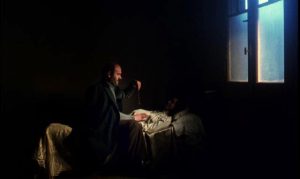
Fragments of childhood memories take on an otherworldly nostalgia as we follow a girl enchanted by her father’s secrets and sadness. As El Sur is an unfinished production, the film also haunts itself.
Good Morning (Yasujiro Ozu, 1959)
To those who think Ozu is intimidating and slow, Good Morning is lighthearted, breezy, funny, and adorable, spinning a tale of childhood mischief and gossip gone awry amidst the burgeoning suburbanization of Tokyo.
The Shining (Stanley Kubrick, 1980)
Since I grew up in a labyrinthine apartment complex, The Shining’s dizzying hallways and uncanny sense of danger behind any door resonates strongly. Profoundly creepy and aesthetically impeccable.
Mystery Train (Jim Jarmusch, 1989)
Laid-back and cool despite its meticulously nested chronological structure, Mystery Train beautifully documents strangers existing in forlorn American landscapes haunted by history and pop culture.

